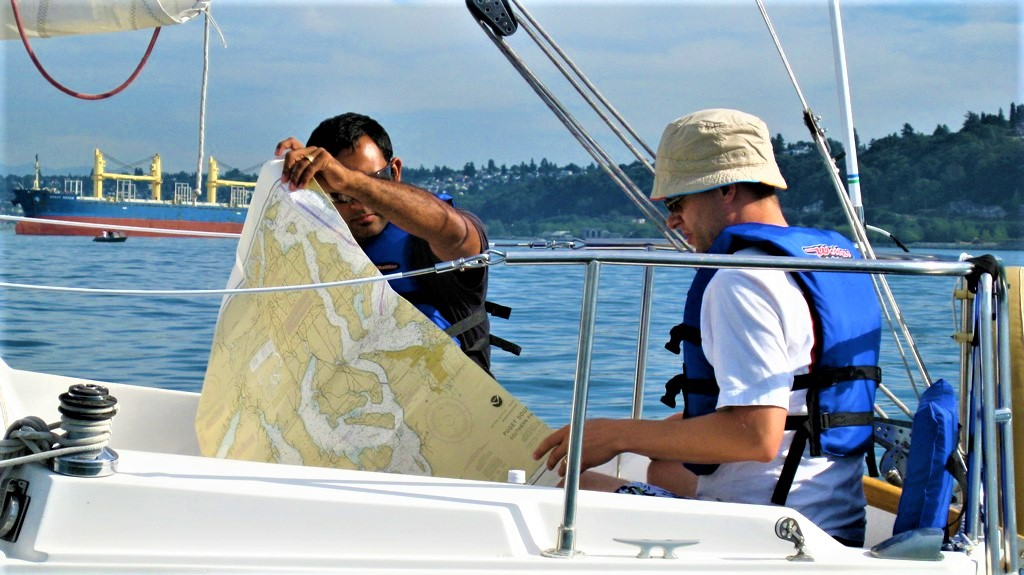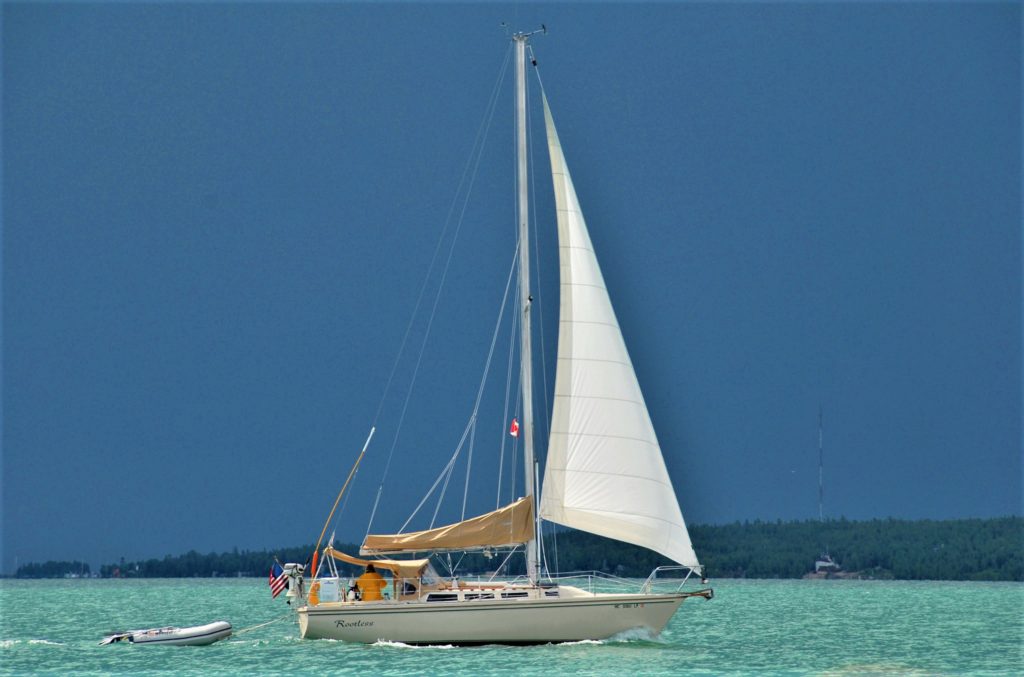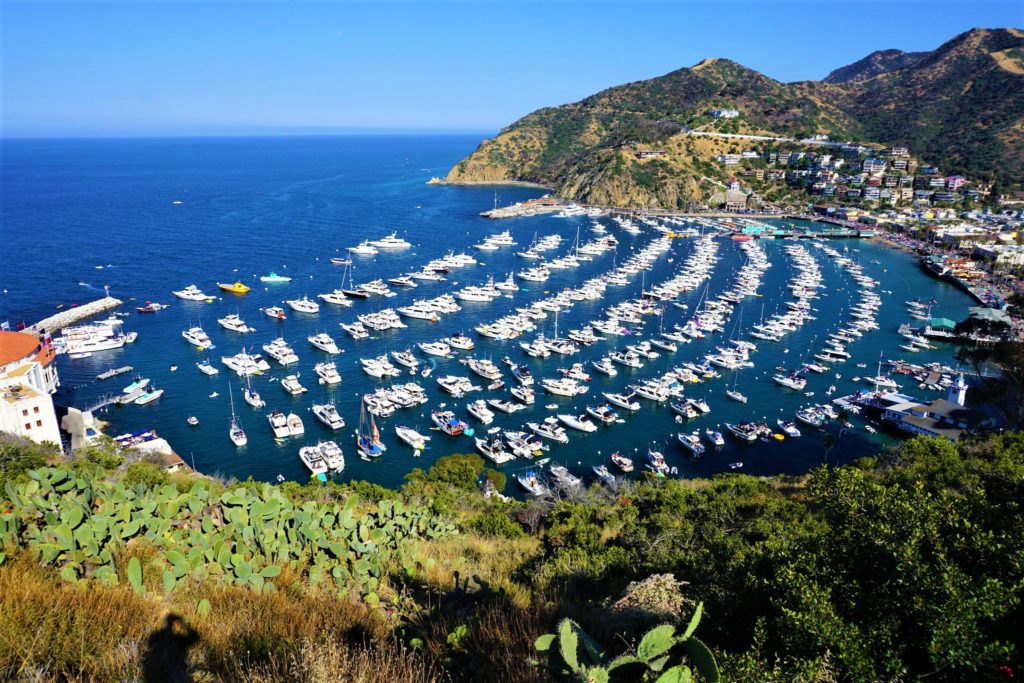
When we decided to charter a yacht for a week in the British Virgin Islands (BVI), I wanted to get formal training to be confident that we could handle the boat safely and be sure the charter company would let us take their boat out when we arrived. In order to do that, I took a series of courses from the American Sailing Association (ASA), along with one of my crew members. The ASA is a widely recognized training standards organization that offers its sailing courses through member schools across the United States. Each course includes a set of competencies that must be demonstrated on the water and on a written test to earn a standardized certification. The three certifications we sought were:
The ASA 104 standard teaches to a multi-day cruise on a 30-45 foot sloop rigged, auxiliary powered, sailboat in coastal waters. “Auxiliary powered” means it has an engine, usually an inboard diesel. ASA 101 and ASA 103 are prerequisites for ASA 104. They teach the basics of sailing, navigating, and seamanship.
We took all three courses with the Island Sailing School & Club in Portland, Oregon and Olympia, Washington. The school is under new ownership and the Olympia site has since closed; all courses are now offered here in Portland.
Considerations for Choosing a School
The location of the sailing school and the types of boats they have for your bareboat charter certification will heavily influence what you learn.
Boat Type
If you’ve never sailed before, taking ASA 101 in the smallest boat possible (under 20 feet) will give you a better feel for the forces involved in sailing than starting out on a big, heavy boat. Smaller, lighter boats are more responsive to changes in the wind and sail control, while big, heavy boats carry so much more momentum that they take more time to respond, making influences on the boat less obvious. Having the opportunity to learn on more primitive equipment that has you do the fundamental work like flake fold, and stow the sails, crawl up to the bow to hoist and lower the jib, steer with a tiller, reef the main, and holding your jib sheet on the winch will make you a more competent sailor when using modern conveniences while giving you the skills to handle older, smaller vessels.
On the other hand, getting experience handling larger boats during training will give you more ability to handle larger boats on your own sooner. You’ll also want the opportunity to use the modern equipment that you’ll likely see on charter boats, such as a roller furling jib, in mast furling mainsail, wheel steering, auto pilot, chart plotter, self-tailing winch, rope clutch, and an electric anchor windlass.
By taking our courses at a club with a variety of boats in the fleet, we took each of the three courses in a progressively larger boat. We started on an 18-foot Santana and worked our way up to a 30-foot Catalina. However, even the Catalina was smaller than most charter boats available in the BVI and it was an older boat that lacked most of the modern equipment mentioned above. It was also the only boat in their fleet with wheel steering, and since we didn’t get much wind on our ASA 104 course, we got very little experience sailing with wheel steering. To do it over again, I would have preferred to take ASA 104 at a school with larger, more modern boat that would be equipped more like the charter fleets in the BVI.

School Location
The challenges and circumstances of the school site will dictate what you learn hands on, and what you learn only theoretically. Will you have an opportunity to experience high winds? Is there a chance you will have days without any winds at all? What about tides and currents? Does the marina have safe space to practice docking?
On the Columbia River in Portland, where we took our ASA 101 and ASA 103 courses, we get relatively consistent winds and weather in the Summer that allows for good sailing in the afternoons. We were fortunate to have one day where weather got heavy (gusts over 20 knots) that required us to reef the sail and experience some relatively violent tacks. The Columbia River offers some strong, consistent current, but there is no noticeable tidal impact in Portland.
We took our ASA 104 class in South Puget Sound, between Olympia and Tacoma. Sailing conditions are less consistent here and we had zero wind for most of the weekend. This resulted in some time learning the finer points of sail trim (to little avail). While motoring, we got to work through some trouble after we overheated a newly rebuilt motor and needed to call for a back to swap boats. On the final day, I earned a new appreciation for foul weather gear (with which I was woefully equipped) when an unexpectedly cold, wet afternoon followed us most of the way home. The tidal currents in the Tacoma Narrows were enough to give you some religion in a small, slow boat.
How to Schedule Your Courses
An expeditious way to accomplish your course work is by hiring an ASA certified skipper for a weeklong bareboat charter. Most bareboat charter companies in North America can help with this. During the week, you’ll work on all three certifications. Everyone on the boat can work on the certifications, which results in a crew that is very well prepared for their next trip. The downsides to this include sharing your vacation with a stranger, lack of variety in your vessel, no time between courses for reflection or practice.
When we took our courses at Island Sailing, we were able to take boats out to practice between our ASA 101 and ASA 103 courses. If you have the time, and can find a school that offers this, you’ll have additional days of experience for your sailing resume as well as real experience to better prepare for your next course, and probably some hard lessons and mistakes made safely close to home. In fact, with enough on-water experience between ASA 101 and ASA 103, you might be comfortable taking out a charter without ASA 104, especially if the boat you use for ASA 103 is a similar size to your charter boat.
What Kind of Experience do You Need to Take These Courses?
My crew mate had no prior boating experience. I had some experience on several boats. You can definitely approach this series with zero time on the water. At the other end of the spectrum, you can challenge courses to get certification or bypass prerequisites to move on to more advanced courses.
Is the ASA 104 Bareboat Cruising Certification Enough?
In North America, including the Caribbean, there are no formal training or competency requirements prescribed by governments, and most charter companies rely on a subjective review of your boating experience by requesting a resume or having you fill out a form. So, there is no formal requirement for a bareboat charter certification in these areas, per se.
Formal Requirements
In some parts of Europe and the South Pacific, there are more formal requirements. Depending on the country, ASA 103 or ASA 104 either directly meet the requirement, or the ASA can issue a corresponding competency certificate for you that meets the requirement. The certificate, which is good for five years, is simply paperwork and a $50 fee, but you do have to be a current member of the Association to order the certificate ($60/year). Since initial membership is included with your coursework, it might make sense to order your certificate before that membership expires.
Take note that there are cruising grounds in Europe, such as Croatia, that are more challenging than the BVI but only have a formal requirement of ASA 103. So, ASA 103 will be viewed by many as more than sufficient for chartering in an easy cruising ground like the BVI, especially if combined with some additional experience.
Practical Competence Requirements
The lessons across these three courses left me feeling very confident. We completed our coursework about six weeks before our first trip to the BVI. While we met challenges on the water that tested our confidence, we ultimately returned with crew and boat unscathed. However, we would have found ourselves in over our heads in a less hospitable waters. What we were lacking, and what we gained on our seven-day trip, was real world experience. Training cannot replace days at sea, and days at sea cannot replace training or coaching from a knowledgeable, competent sailor.
‘Enough’ also comes down to the type of boat and your cruising itinerary. This coursework does not cover night sailing, offshore passagemaking, catamarans, twin engines, planing hulls (powerboats), or larger yachts. You should also consider the needs of the cruising grounds of your next charter and try to get hands on learning with related concepts in your coursework:
- Picking up a mooring buoy
- Mediterranean mooring
- Docking in a slip
- Anchoring in weather
- Anchoring overnight
- Large tidal ranges and currents
The coursework did not allow much time for close quarters maneuvering (docking), and most of the boats at the club had outboards that were a nightmare at the dock, so we never voluntarily practiced for fear of causing damage. I don’t blame the curriculum or the school for this, most boaters approach the dock with trepidation, and I could certainly benefit from a dedicated docking class, such as ASA 118. With the benefit of hindsight, always volunteer to be the one to bring the boat into the slip, because you cannot get better without practice…and your ability to get in and out of the slip will be the top indicator to the charter company as to whether you can handle the boat.
Consider adding ASA 114 for cruising catamaran certification if you don’t have any experience with twin engines. This will help prepare you for renting twin engine powerboats too. Some schools will offer this as a package with ASA 104.
Bottom Line Cost and Time Commitment for Certification
Expect to spend $1,500 to $2,500 to complete all three bareboat charter certifications. Individually, the course prices will range from $500-$900. Each course will typically be offered over 2-3 days, with ASA 104 requiring 1-2 nights cruising on the boat. When taking the courses as a package, expect to spend close to a week living on the boat. While your options will come down to the courses available in your area, or where you are willing to travel, here are some examples of available course offerings:
To breeze through all the material quickly at once, Anacortes Yacht Charters in Washington, offers a Thursday-Sunday sleep aboard for $2,000. This course includes a free half day rental after the class to work on your skills. However, this course is not designed for inexperienced beginners. Full Sail Yacht Charters on Lake Erie in Ohio offers a five-day course for $1,500.
Marina Sailing in Southern California offers several options for the three courses from a $2,000 5 day package to individual courses $675-895, including ASA 114, Sailing Catamaran. Their ASA 104 course can be completed in a two or three-day weekend. Their classes include an initiation fee to the sailing club so you can rent boats for practice.
True North in Jersey City just outside of New York offers ASA 101 over two days for $720; its a bit more expensive because it is offered in a small class on a larger boat. ASA 103 is $600 in two days, or can be combined with ASA 104 in a three-day course for $900.
At the other end of the time spectrum (but still similar pricing), Victoria Sailing School in Denver, Colorado, spreads their courses over a more sessions. ASA 101 includes two classroom sessions and three on water sessions. ASA 103 includes four sessions on two different sized boats. This would be a great path to consider if you don’t plan to take ASA 104. However, their ASA 104 is even more intensive as it includes one classroom session, one day on a 30-footer in Denver, and three days on a larger boat (or catamaran) sailing from Long Beach to Catalina Island in California, which obviously also requires some travel. They also have a fleet of rental boats available for practice.

